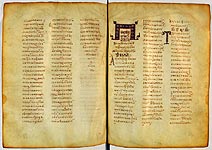Gospel Readings and Readings of the Acts of the Apostles.
10th cent. (last quarter). Constantinople
F (305 ı 218). I+198+I leaves. The end is missing.
Parchment. Ink, cinnabar, colours, gold.
It is written in a Alexandrine uncial hand in three columns. Text has ekphonetic signs.
There are ornamental head-pieces in colours and gold, multicolour initials in Gospel readings and gold initials in readings from the Acts of the Apostles.
The codex is a remarkable and rare example of a 10th-century text, arranged in three columns. It is also notable for its writing, which was generally used for auxiliary parts of texts (headings, colophons, marginalia and etc.) in 10th-century manuscripts written in minuscule script. All this shows creators' aim to imitate ancient codices and create a luxury and great copy. The design of the manuscript is distinguished by well-thought-out proportions of components. The decoration served a purpose to mark the beginning of each section for reading. Multicolour initials indicate Gospel readings. Initials, made purely in gold, mark readings from the Acts of the Apostles. It is evident that artists aimed to made initials for Gospel readings different from illuminated letters for readings from the Acts of the Apostles not only in the colour: the two types also differ in the style of ornamental pattern. The design of the manuscript is one of the early examples of the style, reminiscent of cloisonne enamel, used in initials. The codex was created in a large Constantinople skriptorium in the last quarter of the 10th century, where artists were skilled at the full range of used ornamental patterns.
The manuscript was donated to the Imperial Public Library in 1859 by A. Lobanov-Rostovsky.
Shelfmark: –Õ¡. √˜. 55.





